British Fashion in the Ottoman Empire
Tradition, Reform and the Westernisation of clothes in the Ottoman Empire during the 19th Century.
In this week'due south blog, CS Ambassador Chelsey Lewington shares with us Part Two of A Tale of 3 Empires, examining Tradition, Reform and the Westernisation of dress in the Ottoman Empire during the 19th Century.
by Chelsey Lewington
In Part one I looked into the origins of how the prevalent Western Empires utilised Ottoman wear during the 19th Century [i]. I looked at how the cultural exchange between the Empires was i that was based on "a British and French cultural enterprise" that was ignited by Napoleon'southward invasion of Arab republic of egypt [ii]. I outlined that this cultural exchange was one based on orientalism; a term popularised past Edward Said's text of the same name [3]. Orientalism is the mode that the west has come to envisage the 'east'. The concept is based on colonialist thinking and it is drenched in exotic stereotypes and fantastical notions [4]. The W's love of, and then the eventual 'othering' of, the Ottoman's allowed the west to create an idealised epitome of dress that however permeates into our culture today [five]. They accomplished this by differentiating the Ottomans equally 'Islamic', 'Arab' and 'Persian' which allowed the former admirers to refer to the empire every bit the "sick man of Europe" [6].
We in the due west are led to believe, because of our ethnocentrism (our western Occidental cultural lens), that nosotros are 'authorial experts' on dress. An expertise, however, that is usually based on our own cultural experiences and opinions. This is particularly prevalent within the post-9/11 world where there are hundreds of debates and articles documenting Eye Eastern manner, its relationship to 'western ethics' and the arguments for and against the wearing of Islamic headdresses [7].
Most of the common fashion history that I see pertaining to the Middle E documents it in a unlike way to the Due west. Instead of looking at apparel and tying it into cultural history, it's heavily focused on looking at the ancient and Crusades era of apparel and the fabrics, textiles and embroidery are discussed more dress itself [8]. This is not to say that books looking at Middle Eastern apparel do not be, simply that rather clothes itself under the Ottoman Empire is not really discussed.
In this part, I will expect into what was happening during the Ottoman Empire at the fourth dimension and the garments that the men and women were wearing. I will also mention briefly the differences between dress that Center Eastern women were wearing in gild to highlight the 'othering' that the Europeans were engaging in. Finally, I will look at the European influences seeping into Center Eastern wearing apparel and the consequences of that going into the 20th and 21st Century.
The Ottoman Empire was a state and caliphate that had territories in North Africa, Eastern Europe and the Middle East from the 15th Century [9]. In the 19th Century, whilst the European Empires were expanding, it was apparent to outsiders that the Ottomans were not every bit powerful every bit they once were. They believed that the Empire would fall, however, the biggest question befalling the other powers was who would gain from the Ottoman'south downfall? [10]. The most evident accident which highlighted the weakening ability of the Empire was Napoleon'southward invasion in 1798 [eleven]. The Ottomans were as well facing competition economically from their European counterparts as a result of the industrial revolution. To catch-upwards, a restructuring of the manufacturing process occurred. The subsequent growth of the textile industry led to an overall growth in material production within the domestic market after 1870 [12].
Restructuring also took identify in Constantinople in the guise of institutional reforms. In 1826, Sultan Mahmud Ii (1808-39) oversaw changes to various foundations with various success. Two major changes included the abolition of the Janissary corps for a new regular army that was based on a European model and the establishment of foreign ministries [13]. Mahmud II's son and successor, Sultan Abdulmecid (1839-61) also continued his begetter'due south legacy by establishing a set of various programs and changes that were collectively known as the Tanzimat reforms [14].
Changes inside institutions as well led to a transformation in dress which altered dramatically, especially for men, during the 19th Century. The most well-known alter to occur came with the creation Mahmud 2's new army, the Asakir-i Mansur-i Muhammediye (victorious Muhammedan soldiers). They were provided with a new compatible which originally consisted of keeping the kuvar and the şalvar [15]. Soldiers were then issued to wear a setre and trousers that resembled the fashionable lines of their European counterparts (see fig. 1 and ii) [16]. At that place was one change, still, which angered many within the army. The fez was a headdress that was adopted from the previously modernised Egyptian regular army [17]. Soldiers were so reluctant to abandon the turban that it led to protests which left twoscore people injured [18]. Despite the resistance the fez became an accepted symbol of reform, as it was somewhen worn by most people of all classes and persuasions [nineteen].
On three March 1829, Mahmud II's desire for wearing apparel reforms extended itself to civilians. A decree alleged that only the ulema (Muslim scholars) were permitted to keeping the robe, turban and slippers. Ottoman men were obliged to change their headgear into a fez, wear frock-coats, capes, trousers and blackness leather boots [20]. Later the Ottoman court adopted western suits and uniforms, morning traditional Ottoman garments became informal individual attire [21]. A consequence of the new dress codes meant that the distinctive and colourful appearances of the Ottoman Courtroom had now been abolished. The apparel which delighted Europeans for centuries was now being discontinued in favour of a gradual acceptance of Western fashion. The production of textiles in the Ottoman Empire also helped in the wider acceptance of European dress; by the stop of the 19th Century a Western-influenced mass way arrangement was in place [22].
Women's dress did not get through as much of a drastic change but changes did occur throughout the century. Gloves were worn throughout the century and during the reign of Sultan Abdülaziz (1861-76) women typically wore the yashmak. In Adlhamit II's time, a flimsy white veil was worn but this inverse into a thick black one within the century [23]. Typical Ottoman and Egyptian clothes was documented extremely well through the paintings of John Frederick Lewis, fifty-fifty though he was an Orientalist painter [24]. In Indoor Gossip (1873) and Lilium Auratum (1871) (fig. 3 and 4), all of these elaborate costumes would have been worn over a set of underwear. Underwear typically consisted of a shirt that was very full, similar to those worn by the men, and it fell to just higher up the articulatio genus. Underwear shirts were fabricated of the same material for both men and women and it came in the colour white. It was made from a diverseness of materials including: linen, muslin, silk, cotton and a cotton wool mix [25]. The underwear shirt is similar to the Turkish gömlek. Turkish women would have worn dislik aslope their underwear shirt. Lilium Auratum highlights that Egyptian women would have had their undershirt sleeves edged with gilt. Egyptian women would accept then worn shintiyan, full voluminous trousers that were very like in material and cutting to the Turkish şalvar. Shintiyan's were extremely long in length which meant that they had to be made with drawstrings, so they could be tied up under the knee. This created a graceful bouffant issue over the wearer's ankles. They were made in a wide range of materials from lite printed cottons and muslins to heavier silks fabricated in the rich colours of violet, blueish and pink [26].
Worn over the shintiyan (typically Egyptian) or şalvar (Turkish) trousers was a robe. The robe was akin to the üçetek which was a long slender robe with a trailing skirt. The sleeves were as long and had securely slashed cuffs that fell dorsum over the wrists to reveal the sleeves of the undershirt. Information technology too had slits up the sides that would end at the hip area. There were also shorter jackets that were quite popular. In Egypt, a short jacket known as an anteri could have been worn and in the Ottoman Empire the yelek was a popular culling to the long robe [27]. Robes were available in a wide range of fabrics including silks such every bit a lightly coloured i with contrasting stripes in gilt to deep colours with embroidered patterns and gold couching [28]. To complete the outfit the waist was then encircled by a shawl-like girdle [29].
Headdresses predominantly consisted of a foundation cap wrapped with scarves. In the 19th Century, they were smaller and neater in their extravagant proportions. A rectangular white scarf of cotton, embroidered at each end, was usually thrown over the headdress merely information technology was not found in Turkey at that time [30]. The typical hairstyle was based on various long plaits that hanged down the dorsum. They would accept been threaded with cords that were fastened to little golden ornaments. Kohl and henna embellishments was also generously applied to the face and hands [31].
In the 19th Century, Europeans started to distastefully refer to Ottoman civilisation every bit Persian despite the fact that they were actually a role of the Farsi Empire. The main changes to Western farsi women's wearing apparel came into fruition from the middle of the century. Ladies enjoying an breezy tea party would wear full skirts which varied in length from knee to mid-calf. This was now replaced by wide trousers [32]. Before the Shah embarked to Europe, long, loose embroidered trousers were consequent with the one-time national costume. Talocrural joint-length trousers were besides fashionable but their tight fit and light colour meant that they functioned amend equally undergarments [33]. On his return, however, elements of Farsi women'south apparel that entered into the majestic courtroom were seen every bit 'ungraceful' (fig. five) [34]. Alongside the trousers, a jewelled brassiere was worn equally a scanty decorative item than a functional one [35]. The stylish jackets were all the same in the neat tight shape that was established in the first half of the century and were available in two sizes; short (stopping at the waist) and long. The longer length was paired with a full length skirt. The costume was completed with fibroid white socks or stockings whilst heads were covered with the chargat [37].
European women who visited the Persian Empire during the 19th Century detested the style that Persian women were dressed. In 1850 Lady Sheil, the married woman of the British Minister of Tehran, frankly stated later on visiting the Persian Shah Nassereddin Shah Qajar's female parent that "I do not admire the costume of the Persian women" [38]. It is quite ironic that European women felt negatively, eventually, to all forms of Middle Eastern dress. Despite the fact that Ottoman clothes was worn past women to print on their husbands fantasies, many flush women such as Lady Hester Stanhope, Julia Pardoe and Anne Edgeless adopted Ottoman apparel as a mode to express that they too wanted legal holding, marital and family rights like Muslim women had at that fourth dimension [39].
European influences, particularly French, and cultural ideas made its way into minds of the Turkish aristocracy during the Phanariot Period that occurred in the century. These cultural ideas also paved the way for the acceptance and adoption of European dress [40]. Mahmud Two's wearing apparel reforms upon the male elite allowed this to occur, as the men would be more tolerant to allow the women of their households to adopt European dress too [41]. Women adopting European wearing apparel included the add-on of deep frilled collars, machine-made borders of imported lace on undershirts, heavy ruby-red and regal velvets couched in gilded floral designs, tight-waisted bodices and trailing bell-shaped skirts [42]. Demand was then high that past the latter end of the century, shops offered European fashions to Muslim and non-Muslim clientele. Cultural resistance to the adoption of European fashion and consumer goods came from many Turkish Muslims. This resistance reflected the nationalism that was growing within Muslim and anti-European Turkish communities. This dichotomy around European influences on dress repeat the circuitous economical, political and cultural debates occurring in the Ottoman Empire in the 19th Century.
Even today debates around Middle Eastern clothes continue. One of the most recent and prevalent examples pertains to the exhibition 'Gimmicky Muslim Fashions' which has drawn criticism in Germany for depicting headdresses, for a disregard to the punishment women receive in Iran for violating dress codes and the standard racist and Islamophobic detest mail [43]. Debates around dress reforms and their acceptance inside the Ottoman Empire were an inevitability in the 19th Century. The power of the Empire was weakening whilst the European powers emerged triumphant in the cultural exchanges during the Industrial revolution. The Fashionable elites were more than willing to adopt European dress in the proper noun of reform but even this relationship would plough sour by the offset of the 20th Century. Afterwards Earth War I, the Ottoman Empire ceased to be and the countries which made upwardly the Empire are nonetheless to this 24-hour interval left questioning their national identity and its human relationship to organized religion and the westward. Turkey, who had been at the center of the Empire, decided to implement their own dress reforms which included banning the fez in 1925 [44]. The fez, a controversial particular that came to symbolise reform, took on a new identity as a reminder of a painful past. Information technology symbolised that the reforming and westernisation of Ottoman dress led to the death of the colourful and distinctive garments which fabricated the Ottomans who they were.
Glossary of Terms:
- Anteri – Also referred to equally a yelek, it is a brusk jacket that was fashionable in Egypt during the 19th Century.
- Chargat– a triangular shawl that was draped over the head and fastened under the mentum so the three points could be evenly distributed around the dorsum and chest.
- Dislik – Underpants.
- Gömlek – The Ottoman equivalent of a chemise.
- Kuvar - A male person headdress made of cloth knitted with white cotton thread that is wrapped in a turban.
- şalvar - Amorphous drop-crotch Turkish trousers that were worn by men and women.
- Setre - An one-time-fashioned class of a European coat.
- Shintiyan – Similar to the şalvar, they are loose trousers or drawers worn specially by women.
- Üçetek – A robe with three panels.
- Ulema – Muslim scholars that are recognised as having specialist knowledge of Islamic law and theology.
- Yashmak - A Turkish veil or niqab worn past some Muslim women that covers the confront, simply not the eyes.
- Yelek – The sleeveless and collarless garment is the bodice or waistcoat for Ottoman clothes.
References:
[ane] Lewington, Chelsey (2020) 'Orientalism, Exoticism and Culture Commutation in 19th Century Western Dress Function I', The Costume Guild, 18 May, available at: </weblog/post/orientalism-exoticism-and-the-cultural-exchange-in-19th-century-western-dre> (Accessed 2nd June 2020.)
[2] Said, East. (1978, this edn. 2019) Orientalism Reissued Penguin Classics edn. London: Penguin, p.4. [3] Ibid, pg. 1-five. [4] Ibid, pg. 4. [5] Jirousek, C. and Catterall, Due south. (2019) Ottoman Clothes and Blueprint in the West 1st edn. Bloomington, Indiana, U.s.: Indiana Academy Press, pg. 196. [six] Ibid, pg. 196.
[7] Ane example I found was Bock, P. (2019) 'How a New Headscarf Row has Ignited French Divisions over Islam and Secularism', New Statesman, 15th Oct, available at: <https://www.newstatesman.com/world/europe/2019/10/how-new-headscarf-row-has-reignited-french-divisions-over-islam-and-secularism> [accessed third June 2020.] [8] See for example, Suleman, F. (2017) Textiles of the Middle East and Fundamental Asia: The Material of Life, United kingdom of great britain and northern ireland, London: Thames & Hudson Ltd. And Balfour-Paul, (2011) Indigo: From Mummies to Blue Jeans, U.k.: London, British Museum Press. [9] Rose, C. and Petzen, B., [2013] 15 Minute History [podcast], Episode 26: History of the Ottoman Empire Part I, Available at: <https://15minutehistory.org/podcast/episode-26-history-of-the-ottoman-empire-office-i/> [re-accessed 9th March 2020.] [10] Jirousek, C. Ottoman Dress and Pattern in the Due west, pg. 193. [11] Ibid [12] Ibid, pg. 195. [13] Ibid, pg. 194. [14] Ibid [fifteen] Lindisfarne-Tapper, N. and Ingham, B., (1997) Language of Dress in the Eye E 1st edn. United Kingdom, Surrey: Curzon Printing, pg. 153. Şalvar reference from Jirousek, C. Ottoman Wearing apparel and Blueprint in the Due west, pg. 226. [sixteen] Ibid, pg. 153. [17] Jirousek, C. Ottoman Dress and Pattern in the West, pg. 191. [18] Lindisfarne-Tapper and Ingham, Language of Apparel in the Centre East, pg. 153. [19] Jirousek, C. Ottoman Dress and Design in the West, pg. 191. [xx] Lindisfarne-Tapper and Ingham, Language of Apparel in the Middle Eastward, pg. 153. [21] Jirousek, C. Ottoman Dress and Design in the Due west, pg. 211. [22] Ibid, pg. 192. [23] Lindisfarne-Tapper and Ingham, Linguistic communication of Wearing apparel in the Heart East, pg. 155. [24] Deficient, J. (2003) Women's Costume of the Virtually and Middle Due east, 1st edn. United Kingdom, London: Routledge Curzon, pg. 126. [25] Ibid, pg. 127. [26] Ibid. [27] Ibid. [28] Ibid. [29] Ibid. [30] Ibid, pg. 128. [31] Ibid. [32] Ibid, p. 170. [33] Ibid. [34] Ibid, p. 171. [35] Ibid, p. 172. [36] Ibid, p. 171. [37] Ibid, p. 168. [38] Jirousek, C. Ottoman Dress and Design in the W, pg. 202-204. [39] Scarce, J., Women'due south Costume of the Near and Eye East, p. 111-112. [40] Jirousek, C. Ottoman Wearing apparel and Design in the Due west, pg. 212-213. [41] Scarce, J., Women's Costume of the Near and Center Due east, p. 182. [42] Binder, A. and Grenier, Due east. (2019) 'Muslim Fashion for Women Exhibition Stirs Controversy in Germany', DW, third April, Available at: <https://www.dw.com/en/muslim-fashion-for-women-exhibition-stirs-controversy-in-frg/a-45601007> [Re-accessed on 12th June 2020.] [43] Lindisfarne-Tapper and Ingham, Language of Dress in the Middle East, pg. 173.
Bibliography:
1. Binder, A. and Grenier, E. (2019) 'Muslim Way for Women Exhibition Stirs Controversy in Germany', DW, 3rd April, Available at: <https://world wide web.dw.com/en/muslim-fashion-for-women-exhibition-stirs-controversy-in-frg/a-45601007> [Re-accessed on 12th June 2020]
2. Jirousek, C. and Catterall, S. (2019) Ottoman Dress and Design in the West 1st edn. Bloomington, Indiana, Usa: Indiana Academy Press
three. Lewington, Chelsey (2020) 'Orientalism, Exoticism and Civilisation Substitution in 19th Century Western Dress Part I', The Costume Society, 18 May, bachelor at: </weblog/post/orientalism-exoticism-and-the-cultural-commutation-in-19th-century-western-dre> (Accessed second June 2020)
4. Lindisfarne-Tapper, N. and Ingham, B., (1997) Language of Dress in the Middle East 1st edn. Britain, Surrey: Curzon Press
5. Rose, C. and Petzen, B., [2013] fifteen Minute History [podcast], Episode 26: History of the Ottoman Empire Function I, Bachelor at: <https://15minutehistory.org/podcast/episode-26-history-of-the-ottoman-empire-part-i/> [re-accessed ninth March 2020]
6. Said, E. (1978, this edn. 2019) Orientalism Reissued Penguin Classics edn. London: Penguin
7. Scarce, J. (2003) Women'due south Costume of the Near and Middle East, 1st edn. United Kingdom, London: Routledge Curzon
Farther Reading:
ane. Lewington, Chelsey (2020) 'Orientalism, Exoticism and Culture Commutation in 19th Century Western Wearing apparel Part I', The Costume Order, 18 May, available at: </weblog/post/orientalism-exoticism-and-the-cultural-exchange-in-19th-century-western-dre> (Accessed second June 2020)
2. Scarce, J. (2003) Women'due south Costume of the Virtually and Middle Due east, 1st edn. United Kingdom, London: Routledge Curzon
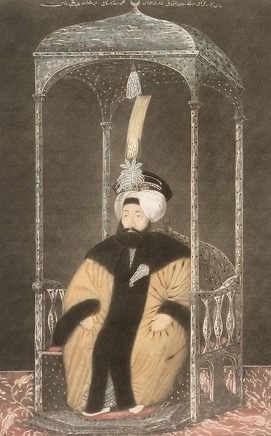
ane. Mahmud Ii earlier dress reform. Unknown Creative person, Mahmud Ii, Istanbul, Topkapi Palace Museum Directories. This portrait is not dated, howeve
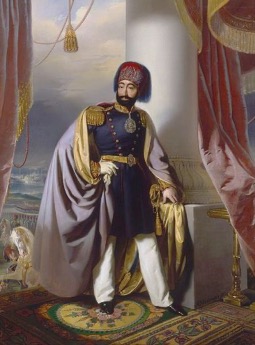
two. Mahmud II's uniform post-reforms. Henri Guillaume Schlesinger, Mahmud II, Ottoman Sultan in 1808, 1839 (most paintings of Mahmud II are d
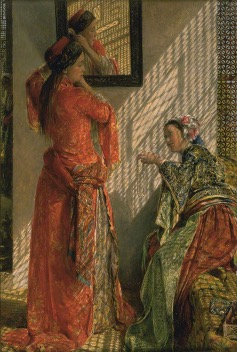
iii. John Frederick Lewis, Indoor Gossip, 1873, Oil Painting. The Whitworth, Academy of Manchester.
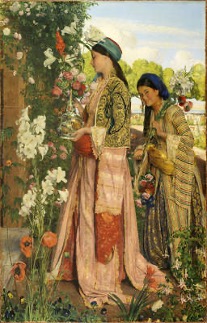
four. John Frederick Lewis, Lilium Auratum, 1871, Oil on Canvas. Birmingham Museums.
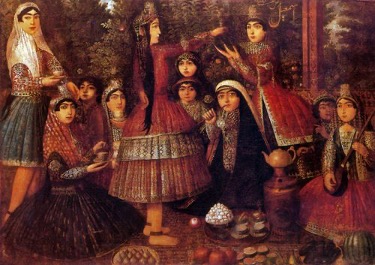
v. Farsi Ladies effectually a samovar. Isma'il Jala'ir, Oil Painting, Persia, c.1865.
"
0 Response to "British Fashion in the Ottoman Empire"
Post a Comment